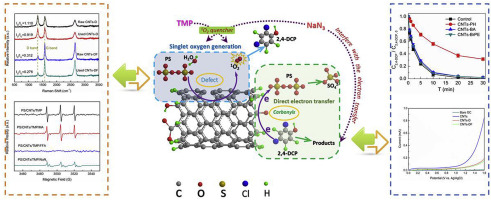Water Research ( IF 11.4 ) Pub Date : 2019-04-01 , DOI: 10.1016/j.watres.2019.03.096
Xin Cheng , Hongguang Guo , Yongli Zhang , Gregory V. Korshin , Bo Yang

|
This study aimed to elucidate the intrinsic mechanisms of PS activation by carbon nanotubes (CNTs). Singlet oxygen generation (1O2) and direct CNTs-mediated electron transfer were hypothesized to be two major pathways of the oxidation of 2,4-dichlorophenol (2,4-DCP) by PS in the presence of both unmodified and modified CNTs. For the first time, roles of CNT active sites responsible for PS activation were determined using CNT derivatization and structural characterization. By selectively deactivating the carbonyl, hydroxyl or carboxylic groups on CNTs surface and linear sweep voltammetry (LSV) analysis, C
O groups were determined to be the main active sites contributing to the direct electron transfer oxidation, while singlet oxygen was generated at CNTs defects. Subsequent UV irradiation was shown to cause the recovery of surface defects with ID/IG of CNTs increasing by 21%. This resulted in the regeneration of the performance for the coupled system and allowed for multi-cycle activation of PS by CNTs. These results suggest that CNTs/PS system combined with regeneration based on UV irradiation can be used as an effective alternative process for continuous degradation of recalcitrant aqueous contaminants through the non-radical mechanism.
中文翻译:

碳纳米管活化的过硫酸盐的非自由基反应机理的见解:活化性能和结构-功能关系
这项研究旨在阐明碳纳米管(CNT)激活PS的内在机理。假设单态氧的产生(1 O 2)和直接的CNTs介导的电子转移是在未改性和改性CNTs存在下PS氧化2,4-二氯苯酚(2,4-DCP)的两个主要途径。首次使用CNT衍生化和结构表征确定了负责PS活化的CNT活性位点的作用。通过选择性地使CNT表面上的羰基,羟基或羧基失活并进行线性扫描伏安法(LSV)分析,C
O基团被确定为导致直接电子转移氧化的主要活性位点,而在CNTs缺陷处产生了单线态氧。随后的紫外线照射显示出表面缺陷的恢复,CNT的I D / I G增加了21%。这导致了耦合系统性能的再生,并允许碳纳米管对聚苯乙烯进行多周期活化。这些结果表明,CNTs / PS系统与基于紫外线辐射的再生相结合可以用作通过非自由基机理连续降解顽固性水性污染物的有效替代方法。







































 京公网安备 11010802027423号
京公网安备 11010802027423号